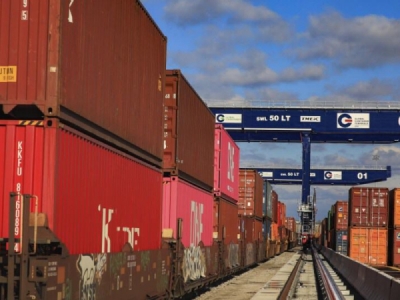
Posted on June 24, 2019
Opening of fourth on-dock rail yard posits NY-NJ to gain greater share of discretionary cargo.
The Port Authority of New York and New Jersey said this week that it is ready to be the second largest port in the U.S., thanks to the completion of the ExpressRail Port Jersey facility at the GCT Bayonne marine terminal.
The Port Authority said in a none-too-subtle way that it “bolstered its already lofty ranking” among other U.S. ports with its third on-dock rail yard, joining three other facilities in Elizabeth, Newark and Staten Island.
Those facilities, along with $4 billion in capital upgrades and the raising of the Bayonne Bridge, mean the port “is poised to surpass Long Beach and become the nation’s No. 2 busiest cargo port for the first time in more than two decades,” it added.
From January through April 2019, the Port of New York and New Jersey reported 1.69 million twenty-foot equivalent units (TEU) of loaded containers compared to the Port of Long Beach’s 1.67 TEUs for the same period.
Overall, the Port of New York and New Jersey saw volume grow from 2.6 million in 2009 to almost 4.1 million in 2018, about 5 percent per year on average.
With an annual capacity of 250,000 container lifts, ExpressRail Port Jersey connects GCT Bayonne to CSX and Norfolk Southern’s rail networks. The intermodal rail facility consists of eight tracks for active loading and unloading of cargo from GCT Bayonne that connect to two lead tracks to and from the main freight rail network.
It also consists of support and train storage track and two high-efficiency, all electric, regenerative powered, widespan, dual cantilevered rail mounted gantry cranes featuring LED lighting to load and unload containers in the intermodal yard.
The port said the ExpressRail service in Bayonne allows the port to advance its five-year strategic goal to handle more than 900,000 rail lifts a year. It said those lifts mean 1.5 million fewer truck trips. “which will greatly reduce congestion and greatly enhance air quality.”
“The rail facilities were designed to reduce the port’s historical heavy reliance on trucks to transport cargo and expands its geographic cargo reach to inland hubs,” the port added.
Trucks account for moving 85 percent of all containers through the port’s terminals. Over the 12-month period ending in April, the Port handled 663,000 rail lifts.
The goal, of course, is gaining greater share of discretionary cargo that could flow through other ports. Port of New York and New Jersey noted that 75 percent of ocean carrier service make the port their first East Coast call. That allows shippers to quickly disembark and reach inland markets.
Given the efficiency with which the Port’s terminal operators and ExpressRail move containers to and from growing markets, the largest ships have dramatically increased the number of containers unloaded and loaded here rather than at ports further down the coast.
The completion of this intermodal rail project “will only help to bolster our already strong position in attracting international cargo destined for the northeast region and beyond,” said Port Authority Chairman Kevin O’Toole.
Source: freightwaves.com





